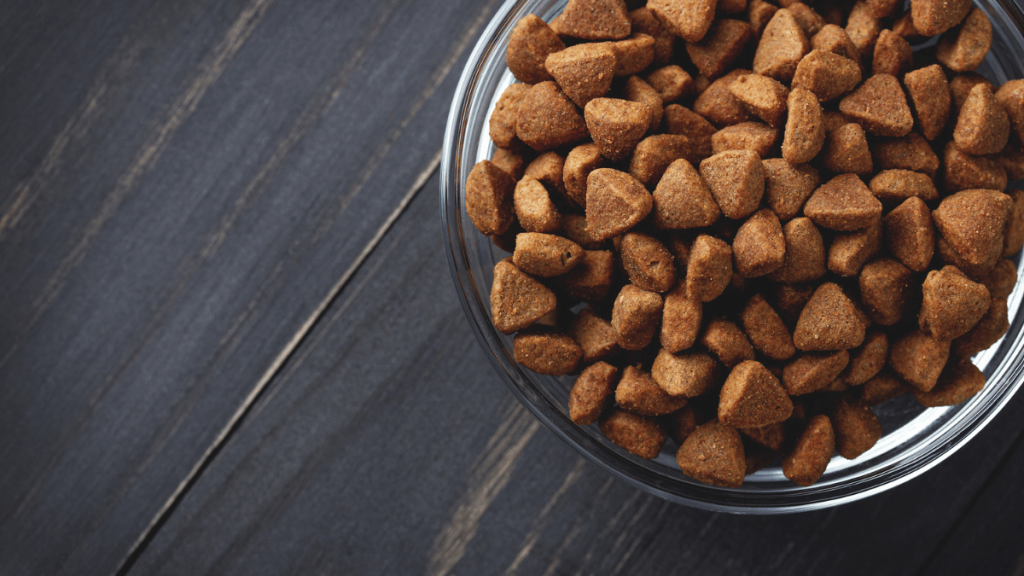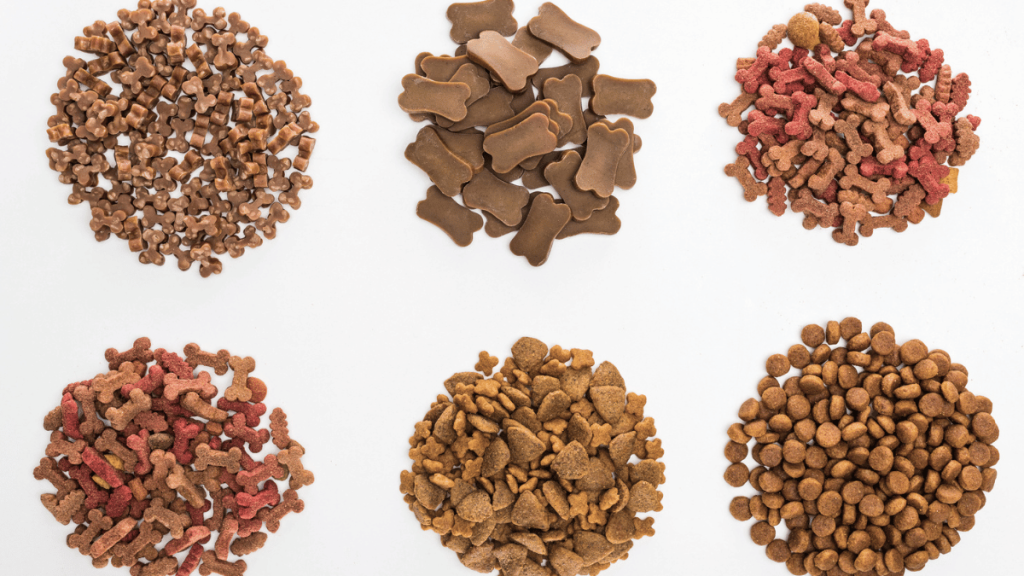Choosing the right dog food is an important decision for any pet parent, especially if they have a dog who eats anything that’s put in front of them. Food directly impacts your dog’s health, vitality, and overall well-being, and with countless options available, it can be overwhelming to navigate the aisles of pet stores or the vast online marketplace to choose the healthiest dry dog food for your pup. We hope to demystify the process for you.
Every dog is unique, and things like their age, size, and how active they are really matter when figuring out the best dry dog food for them. For example, puppies require different nutritional requirements than senior dogs, while high-energy breeds may need a diet with increased protein content.
Beyond the basics, it’s super important to think about any health problems or dietary restrictions your dog might have. If your fur baby suffers from common concerns such as allergies, sensitivities, and weight management, these can be addressed through careful food selection. But, first things first, let’s start by unpacking dog nutrition.
Understanding Your Dog’s Nutritional Needs

Just like us, dogs need a balanced mix of nutrients for optimal health. Ideally, your dog should eat foods that contain protein, fat, carbs, vitamins, and minerals. But how much of what and when is a slightly more complex computation that requires a bit of knowledge about what these nutrients essentially do.
Before we get into it, it’s also important to remember that your dog’s nutritional needs can change throughout their life. Regular check-ups with your vet and monitoring your dog’s health will help ensure they receive the best possible nutrition.
Protein
Builds and repairs muscles, supports organs, and regulates metabolism. Protein is needed for the creation of muscle mass, so, ensuring your dog and or puppy consumes enough protein is vital especially if they are very active. It also helps keep important organs like the heart, liver, and kidneys in good shape.
Sources: Chicken, beef, fish, lamb, eggs, dairy products.
Fat
Provides energy, supports brain function, and maintains healthy skin and coat. A dog’s general health depends on having enough healthy fats — they help absorb essential nutrients, boost brain growth, and keep their coat and skin looking good.
Sources: Animal fats, plant oils (like flaxseed, salmon, and olive).
Carbohydrates
Also provide energy, support digestive health, and fiber aids digestion. While dogs don’t need as many carbs as humans, they still require them for energy and to support healthy digestion. Carbohydrates high in fiber can also help regulate bowel movements.
Sources: Grains (rice, corn, wheat), vegetables, fruits.
Vitamins
Support various bodily functions like vision, bone health, and immune function. Vitamins are important nutrients that help out with a bunch of things that your dog’s body does. They keep your dog’s vision sharp, bones strong, immune system robust, and overall energy up.
Examples: Vitamins A, D, E, K, B.
Minerals
Crucial for bone health, muscle function, and overall metabolism. These naturally inorganic compounds play a supporting but significant role in several body functions. They help strengthen your fur baby’s bones and teeth, keep their muscle function healthy, and regulate their metabolism.
Examples: Calcium, phosphorus, iron, zinc, magnesium.
Water
Fresh water is just as important as the food you give your dog. It aids in digestion, leads to the proper functioning of their kidneys, and also in thermoregulation. Think of it like this: water is like the fuel that helps their bodies run smoothly.
Balance is Key
Now that you know about the essential nutrients and what they do, you’ll be able to better appreciate why your dog’s food should have a good balance of all of them. Too much protein can burden kidneys, while too little protein can lead to muscle weakness and impaired organ function. Not getting enough carbs can mess with your dog’s digestion and leave them feeling low on energy. And if they miss out on those essential vitamins and minerals, they may face health problems like skin issues, a weak immune system, and even poor bone health.
Commercial dog foods often have an AAFCO label, showing they meet nutritional standards. If you’re thinking of making your dog’s food at home, make sure it’s complete and balanced. Your vet can give you some great advice on this.
Types of Dry Dog Food

Dry dog food comes in various forms and formulations, each catering to specific dietary needs and preferences. Here’s a breakdown of the different types of dry dog food:
- Kibble is small, crunchy pieces that help with dental health. It’s also convenient to store and transport.
- Extruded food is typically kibble-shaped but may have different textures. It is highly digestible and palatable due to its manufacturing process, but it may contain artificial preservatives or fillers.
- Baked food is a wholesome option made with whole grains and natural ingredients, but it may be higher in calories and fat.
- Grain-free food is suitable for dogs with grain allergies or sensitivities, but it may be linked to dilated cardiomyopathy in some dogs.
- Limited-ingredient food is ideal for dogs with allergies or sensitive stomachs, but it may not provide a complete and balanced diet on its own.
- Life stage formulas are tailored to specific life stages like puppy, adult, senior, and weight management. Ensure the formula meets your dog’s specific nutritional needs.
- Specialty diets, as the name suggests, are made to help dogs with certain health problems, like kidney disease, heart disease, or skin allergies. Consult with your veterinarian to determine the best specialty diet.
How Can You Tell if Dry Dog Food Is Good?

Choosing the best dry dog food can be a daunting task with so many options available. But, if you use some key factors as a guide, you should be able to decide if a particular brand or formula is suitable for your dog.
Check the Ingredients List
The best dog food brands will have a clear and transparent ingredient list. Look for a named protein source, such as chicken, beef, or fish, as the first ingredient. Avoid foods that list vague terms like “meat meal” or “animal by-products” as primary ingredients, as these can be lower quality.
Look for AAFCO Certification
The Association of American Feed Control Officials (AAFCO) sets nutritional standards for pet foods in the United States. Look for their certification on the dog food label.
Evaluate the Nutritional Content
Ensure that the nutritional content on the label aligns with your dog’s dietary needs. The best dry dog food will have a balanced ratio of proteins, fats, and carbohydrates, along with essential vitamins and minerals.
Check the Calorie Content
Consider your dog’s age, size, activity level, and any health conditions when evaluating the calorie content.
Observe Your Dog’s Health and Behavior
Pay attention to your dog’s overall health, energy levels, coat condition, and stool quality after switching to a new food. Changes or improvements for the better can be a strong indicator of a good product.
Read Reviews and Seek Recommendations
The pet parent community is a wonderful thing — you can explore their reviews and ask for feedback on certain products. Their first-hand experience can tell you a lot about the quality and taste of dry dog food.
Age and Size Considerations in Dog Food Selection

Selecting the right dog food involves more than just picking a brand or flavor; it requires careful consideration of your dog’s age and size. For instance, the best dry dog food for large dogs will differ from one for smaller breeds, and the same goes for their life stages.
Age Considerations
Puppies
Puppies require a diet rich in protein and calories to support their rapid growth and development. Seek out formulas specifically designed for puppies, which typically contain elevated amounts of essential nutrients such as calcium and phosphorus, along with DHA, an omega-3 fatty acid that aids in brain and vision development.
Adult Dogs
Once dogs reach adulthood, their nutritional needs stabilize. Adult dog food is designed to maintain their health and energy levels without promoting excessive weight gain. Consider your dog’s activity level when choosing a food with appropriate calorie content.
Senior Dogs
As dogs age, their metabolism slows down, and they may become less active. Look for dog food formulated to address these changes. Such food will contain fewer calories to prevent weight gain and additional nutrients to support joint health and mobility.
Size Considerations
Small Breeds
Small breed dogs have faster metabolisms and often require more calories per pound of body weight compared to larger breeds. Consider more calorie-dense food which comes in smaller kibble sizes to accommodate their smaller mouths and teeth.
Medium Breeds
Their diet should provide a balanced mix of nutrients to support their moderate energy levels and maintain a healthy weight. Keep an eye on their portions to make sure they don’t overeat.
Largs & Giant Breeds
Large dogs have unique dietary needs due to their size and growth patterns. They are prone to joint issues, so their food should include joint-supporting nutrients like glucosamine and chondroitin. A diet featuring lower fat content might also help these dogs stay slim since being overweight can make joint problems worse.
How to Transition to Dry Dog Food

Transitioning your dog to dry dog food should be done gradually to avoid digestive upset. Here’s a step-by-step guide:
Step 1 – Introduce Gradually: Start by mixing a small amount of the new dry food with your dog’s current food. Gradually increase the proportion of dry food over several days. Here’s a suggested schedule:
Days 1-2: Mix 25% dry dog food with 75% of the current food.
Days 3-4: Mix 50% dry dog food with 50% of the current food.
Days 5-6: Mix 75% dry dog food with 25% of the current food.
Days 7-10: Serve 100% dry dog food.
Step 2 – Monitor for Tolerance: Keep an eye on your dog’s digestive system during the transition. Look for any signs of discomfort, such as diarrhea or vomiting.
Step 3 – Adjust as Needed: If your dog experiences digestive issues, slow down the transition or try a different food.
Step 4 – Complete Transition: Once your dog has adjusted to the new food, you can gradually eliminate their old food altogether.
Tips for a Smooth Transition:
- Offer Fresh Water: Ensure your dog has access to plenty of fresh water during the transition to help with digestion.
- Patience is Key: The transition process may take a few weeks, so be patient and consistent.
Consult Your Veterinarian: If you have any concerns or questions, consult with your veterinarian for personalized advice.
What Do Vets Say About Dry Dog Food?

Veterinarians generally see dry dog food as a handy and balanced option for most dogs. They stress how important it is to choose kibble that is of good quality and meets AAFCO guidelines. Vets often suggest looking for the healthiest dry dog food with a good mix of proteins, fats, carbs, vitamins, and minerals. They also note that kibble can help clean your pooch’s teeth — which is an added advantage because kibble has a very crunchy texture.
But vets warn that not all dry foods are the same, and it’s crucial to pick a product that suits your dog’s specific needs, considering things like age, size, and any health issues. Your vet can help you choose the best dry dog food, as they can give you personalized advice based on your pet’s requirements.
Can Dogs Eat Dry Dog Food Everyday?

Yes, dogs can safely eat dry dog food every day. In fact, many veterinarians recommend a primarily dry food diet due to its convenience, shelf stability, and dental benefits. Some of the best dog food brands typically have a formula that provides a complete and balanced diet, meeting your dog’s essential nutritional needs. Always make sure your dog has access to plenty of fresh water to aid digestion and hydration.
However, it’s important to note that while dry food is a great option for most dogs, it may not be suitable for all. Some dogs may have specific dietary needs or preferences that require a different approach. For example, dogs with dental issues or those prone to dehydration may benefit from a combination of dry and wet food.
So, there you have it! Choosing the right dry dog food is all about finding the perfect fit for your furry friend. Think about their age, size, energy level, and any health issues. Ask your vet for professional, one-on-one help, and always pay attention to how your dog looks and feels. You can also do a quick ‘how to choose dog food’ Reddit search and see what other pet parents are recommending. Finding the healthiest and tastiest dog food for your puppy is possible with some effort and study on your part. Happy feeding!
FAQ
What to look out for when buying dry dog food?
When buying dry dog food, look for high-quality protein sources like chicken, beef, or fish, and choose whole grains over refined grains. Avoid artificial colors, flavors, and preservatives, and ensure the food is certified by the AAFCO to meet nutritional standards. Finally, factor in your dog’s specific needs based on their age, size, and health conditions.
How do you pick the best dog food for your dog?
Choosing the best dog food requires taking into account a long list of things, including your dog’s age, size, and activity level, any underlying health concerns, the quality of the ingredients and nutritional content, your dog’s preferences and sensitivities, and suggestions from your veterinarian.
What type of dry dog food is good for dogs?
A good dry dog food features a named protein as the first ingredient, is AAFCO-certified for balanced nutrition, and most importantly, suits your dog’s specific age, size, and health needs.
What to avoid when buying dry dog food?
When buying dry dog food, avoid artificial colors, flavors, and preservatives, excessive fillers like corn, wheat, or soy, foods with low-quality protein sources, and foods that don’t meet the nutritional standards set by the AAFCO.
What should the first 5 ingredients be in dog food?
The first 5 ingredients in dog food should ideally be high-quality protein sources like chicken, beef, or fish, whole grains like brown rice or oats, healthy fats like flaxseed or salmon oil, vegetables and fruits for added nutrients, and sources rich in vitamins and minerals.
How do you judge dog food quality?
Look for premium ingredients, AAFCO certification, and positive changes in your dog’s health when evaluating dog food quality. For individualized guidance, speak with your veterinarian and stay away from artificial additives.
Which is the best dog food brand?
Choosing the best dog food brand depends on your dog’s individual needs and preferences but reputable options like Royal Canin, Hill’s Science Diet, and Blue Buffalo are often recommended for their high-quality ingredients, AAFCO certification, and formulations tailored to different breeds, ages, and health conditions. You can research different brands, read reviews, and consult with your veterinarian for personalized recommendations.
What dog food do vets not recommend?
Veterinarians generally do not recommend dog foods that contain low-quality protein sources, excessive fillers like corn, wheat, or soy, artificial colors, flavors, preservatives, or ingredients linked to health problems.
What are the disadvantages of dry dog food?
The disadvantages of dry dog food include lower moisture content, which may not be ideal for dogs needing extra hydration, the potential for lower palatability compared to wet food, and the risk of containing fillers or artificial additives in lower-quality brands.
What should I look for in quality dog food?
In quality dog food, look for a named protein as the first ingredient, AAFCO certification for balanced nutrition, natural ingredients without artificial additives, and a formula tailored to your dog’s age, size, and health needs for optimal well-being.
How much moisture should dry dog food have?
Dry dog food typically has a moisture content of around 10-12%. It is this low moisture content that helps to preserve the food and makes it easier to store and transport. However, some dogs may benefit from a slightly higher moisture content, especially those with sensitive skin or kidney problems.
How do I know if my dog’s food is good for him?
You’ll know your dog’s food is good if they maintain a healthy weight, have a shiny coat, have normal energy levels, and enjoy effortless digestion.
What is the number 1 healthiest dog food?
The number 1 healthiest dog food can vary based on individual needs. However, brands like Hill’s Science Diet, Royal Canin, and Orijen are often praised for their high-quality ingredients and balanced nutrition.











